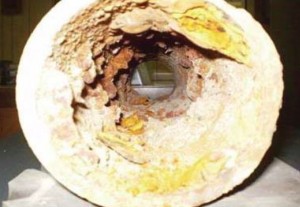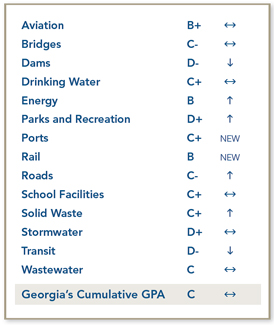This Week in Infrastructure: The Cascading Effect of Aging Infrastructure
December 19th, 2014 | By: Olivia Wolfertz
As the weather changes and our infrastructure continues to be neglected, issues and disruptions are increasing. Infrastructure collapses, like the water main break in DC, remind us that failing infrastructure is fragile and unpredictable—and should be continuously maintained to help prevent a crisis. On Tuesday in Washington, D.C., a 12-inch water main ruptured below ground, flooding three subway lines and damaging the streets above it. According to DC Water, the pipe was 61 years old, a relatively young pipe among a system with a median age of 79 years. Some pipes in the system even date back to the Civil War era. DC’s drinking water infrastructure requires $1.6 billion in upgrades over the next 20 years and the sewer system needs $2.5 billion in fixes. There are 240,000 water main breaks per year and one every two minutes in the United States because of aging pipes. The DC water main break, which affected both the metro rails and streets above, shows the domino effect of one piece of infrastructure’s impact on others. DC is not the only place where aging infrastructure has shouted for investments. This week, the Nevada Section of ASCE released its state Report Card, where the overall grade was a C-. The report points to the state’s great transportation and infrastructure needs to be discussed in next year’s legislation session. In an op-ed piece from Vermont, the author called for stronger dam legislation, citing the Report Card for Vermont’s Infrastructure’s data. Due to increasing visible need for infrastructure repair, more and more states are taking action to fund infrastructure projects through various measures. In Washington, Gov. Jay Inslee unveiled a 12-year, $12 billion transportation proposal, which would be paid for with fees and a new carbon pollution charge. States like Michigan, Tennessee and North Carolina are also pushing for transportation funding at the state level. Though action on the state level to increase infrastructure funds is encouraging, the best thing for our nation and our economy is to fix the Highway Trust Fund and increase the national gas tax to match inflation.Tags: dams, highway trust fund, infrastructure, infrastructure report card, state report cards, water, water infrastructure
No Comments »
Nevada Report Card Reveals a $15B Infrastructure Problem
December 16th, 2014 | By: Infrastructure Report Card
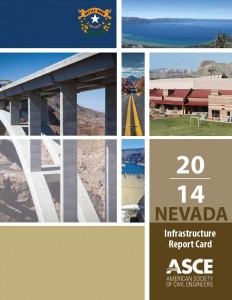 During the past twenty years Nevada experienced one of the largest growth surges in the country and then one of the worst downturns from late 2008 through 2013. This roller coaster economy decreased funding levels and preventive maintenance suffered leaving many infrastructure systems underfunded. Hardest hit may be school facilities in both rural communities and cities. Nevada’s funding for maintaining schools stagnated and left a funding shortfall of over $5 billion during the next 5 to 10 years.
The 2014 Report Card for Nevada’s Infrastructure, released today by the Nevada Section of the American Society of Civil Engineers (ASCE), gave the state’s infrastructure a grade of “C-.” The Report Card identifies more than 15 billion in needs across Nevada’s critical infrastructure sectors over 20 years, including:
Dams and Flood Control:
During the past twenty years Nevada experienced one of the largest growth surges in the country and then one of the worst downturns from late 2008 through 2013. This roller coaster economy decreased funding levels and preventive maintenance suffered leaving many infrastructure systems underfunded. Hardest hit may be school facilities in both rural communities and cities. Nevada’s funding for maintaining schools stagnated and left a funding shortfall of over $5 billion during the next 5 to 10 years.
The 2014 Report Card for Nevada’s Infrastructure, released today by the Nevada Section of the American Society of Civil Engineers (ASCE), gave the state’s infrastructure a grade of “C-.” The Report Card identifies more than 15 billion in needs across Nevada’s critical infrastructure sectors over 20 years, including:
Dams and Flood Control:
- With the majority of funding for flood management coming from local gas and sales tax initiatives, there continues to be projected funding shortfalls upwards of $400 million.
- The state has 158 high hazard dams, which could lead to loss-of-life or significant property damage if dam failure occurs.
- The state budget for high hazard dams is nearly half the national average.
- In 2005, $500,000 of investments were made in aviation through the Nevada Aviation Trust Fund, resulting in an economic impact of over $20 million. However, since that time no state funding has been allocated into the Trust Fund to leverage federal funding.
- The Nevada Department of Transportation maintains 5,300 miles of state highways, which include many rural roadways within Nevada.
- Current funding levels provide only 60 to 70 percent of the required funding to maintain state highways.
- In Clark and Washoe Counties, 45 percent of schools are more than 30 years old.
- In other counties throughout the state, there are schools with campuses over 100 years old.
- Every dollar held back from school operation and maintenance budgets escalates emergency repair budgets 400 percent.
Tags: #HighwayTrustFund, dams, flood control, Nevada, report card, roads, schools
No Comments »
8 Things Worth Knowing About Montana’s C- Infrastructure
November 19th, 2014 | By: Infrastructure Report Card
Montana’s Water Pipes Could Stretch From Billings to Miami – Roundtrip Montana has approximately 700 public water systems and over 5,300 miles of water distribution and transmission piping, a longer stretch than driving roundtrip from Billings to Miami. Some Pipes Under Original Montana Plots Might Be Original Too Some of the older and more established communities in Montana have pipes that date back to the late 1800s and early 1900s and much of the pipe has never been replaced. It is not uncommon for the pipelines in originally established areas to have clay tile pipe that has cracked or failed. Montana’s Rough Roads Are Rough On Budgets 46% of major roads in Montana are in poor to mediocre condition and 40% of gravel roads are in poor or failed condition. These rough roads cost each Montanan approximately $292 to $484 per year in extra maintenance costs depending on their area’s roads. Montana School Buildings Need Some T.L.C. A bottom-to-top statewide school facilities review revealed that 66% of schools showed signs of damage and wear, as well as environmental needs such as HVAC, roof, and electrical issues. Old Dams Don’t Necessarily Have to Be Inspected The overall condition of Montana’s dams is difficult to track because 75% do not have periodic engineering inspections and are not required to have operation permits. Transit Funding Recently Spiked Several agencies benefited from over $15 million in Federal recovery investments in 2009, which essentially doubled short-term transit funding in the state. Montana’s Trash Ends Up In Less Places Since 1993, significant improvements have occurred within Montana’s solid waste infrastructure and operations, including a reduction from over 300 facilities statewide to just 31. Replacing Montana’s Water and Wastewater Infrastructure Could Cost More than 500 Bobcat Stadiums Current estimates to completely replace Montana’s entire water and wastewater infrastructure are estimated to range between $12 billion and $15 billion, or in other terms, more than 500 Montana State University’s Bobcat Stadiums. Find out more about the inaugural Report Card for Montana’s Infrastructure!Tags: dams, infrastructure, Montana, pipes, report card, schools, water
No Comments »
Infrastructure in Arkansas Earns D+
October 17th, 2014 | By: Infrastructure Report Card
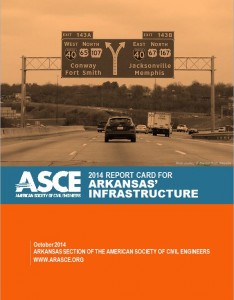 This Thursday, the Arkansas Section of the American Society of Civil Engineers released their inaugural Infrastructure Report Card for the state grading the states’ infrastructure.
Arkansas’ infrastructure received a cumulative GPA of “D+” in the 2014 Report Card for Arkansas’ Infrastructure. The seven infrastructure categories evaluated in the report include:
Roads (D+)
Drinking water (D+)
Transit (D+)
Levees (D)
Dams (D)
Bridges (C+)
Wastewater (C+)
The report noted that Arkansas has the 12th largest highway system in the nation, as well as the second highest traffic fatality rate in the country as of 2010. In addition, the state has 214 wastewater treatment facilities that will need upgrades and improvements in the next 20 years.
The Report Card, the first for Arkansas, was released during the annual ASCE Arkansas Section Conference and included a keynote address by Scott Bennett, director of the Arkansas State Highway and Transportation Department. The report was featured in both the Arkansas Democrat-Gazette and the Times-Record. The effort was led by Aaron Robinson, P.E., based in Jacksonville, Arkansas.
Read the full Arkansas Report Card
This Thursday, the Arkansas Section of the American Society of Civil Engineers released their inaugural Infrastructure Report Card for the state grading the states’ infrastructure.
Arkansas’ infrastructure received a cumulative GPA of “D+” in the 2014 Report Card for Arkansas’ Infrastructure. The seven infrastructure categories evaluated in the report include:
Roads (D+)
Drinking water (D+)
Transit (D+)
Levees (D)
Dams (D)
Bridges (C+)
Wastewater (C+)
The report noted that Arkansas has the 12th largest highway system in the nation, as well as the second highest traffic fatality rate in the country as of 2010. In addition, the state has 214 wastewater treatment facilities that will need upgrades and improvements in the next 20 years.
The Report Card, the first for Arkansas, was released during the annual ASCE Arkansas Section Conference and included a keynote address by Scott Bennett, director of the Arkansas State Highway and Transportation Department. The report was featured in both the Arkansas Democrat-Gazette and the Times-Record. The effort was led by Aaron Robinson, P.E., based in Jacksonville, Arkansas.
Read the full Arkansas Report Card
Tags: Arkansas, bridges, dams, infrastructure, levees, report, report card, roads, transit, wastewater, water
No Comments »
Vermont Infrastructure Shows Improvement in New Report Card
October 17th, 2014 | By: Infrastructure Report Card
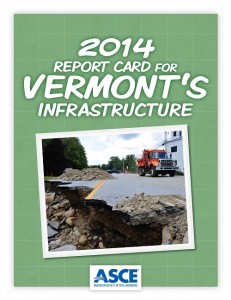 The latest Report Card for Vermont’s Infrastructure showed a slight improvement in their overall GPA to a “C.” The 2014 Report Card for Vermont’s Infrastructure is an update from 2011, when the state received a “C-” cumulative grade. The Report Card assessed bridges (C), dams (C), drinking water (C-), wastewater (D), roads (C-), and solid waste (C+).
After Tropical Storm Irene damaged the state’s infrastructure backbone in 2011, Vermont made significant investments through catch-up and emergency funding. In addition, the state’s most recent transportation funding package provided close to $700 million for transportation infrastructure, the largest transportation infrastructure investment in state history. There have also been programmatic changes. Road fatalities have been cut nearly in half since 2006 due to changes made using the Strategic Highway Safety Plan.
Led by Amanda Hanaway-Corrente, P.E. who chaired the effort and Vermont Section President-Elect Jessica Clark Louisos, P.E., the Report Card was released at a luncheon in Montpelier, which included a keynote from Sue Minter, deputy secretary at the Vermont Agency of Transportation (VTRANS) and David Mears, commissioner of the Department of Environmental Conservation.
“Vermont is poised to grow our economy as we continue to make investments into our infrastructure. The transportation funding that was signed into law in June is one example of how the state continues to focus on innovation and jobs,” said Minter.
Media coverage of the event included the Burlington Free Press and WCAX.
Read the full Vermont Report Card
The latest Report Card for Vermont’s Infrastructure showed a slight improvement in their overall GPA to a “C.” The 2014 Report Card for Vermont’s Infrastructure is an update from 2011, when the state received a “C-” cumulative grade. The Report Card assessed bridges (C), dams (C), drinking water (C-), wastewater (D), roads (C-), and solid waste (C+).
After Tropical Storm Irene damaged the state’s infrastructure backbone in 2011, Vermont made significant investments through catch-up and emergency funding. In addition, the state’s most recent transportation funding package provided close to $700 million for transportation infrastructure, the largest transportation infrastructure investment in state history. There have also been programmatic changes. Road fatalities have been cut nearly in half since 2006 due to changes made using the Strategic Highway Safety Plan.
Led by Amanda Hanaway-Corrente, P.E. who chaired the effort and Vermont Section President-Elect Jessica Clark Louisos, P.E., the Report Card was released at a luncheon in Montpelier, which included a keynote from Sue Minter, deputy secretary at the Vermont Agency of Transportation (VTRANS) and David Mears, commissioner of the Department of Environmental Conservation.
“Vermont is poised to grow our economy as we continue to make investments into our infrastructure. The transportation funding that was signed into law in June is one example of how the state continues to focus on innovation and jobs,” said Minter.
Media coverage of the event included the Burlington Free Press and WCAX.
Read the full Vermont Report Card
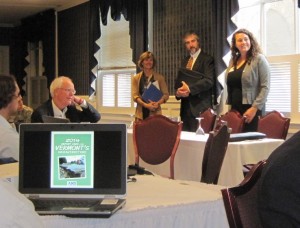

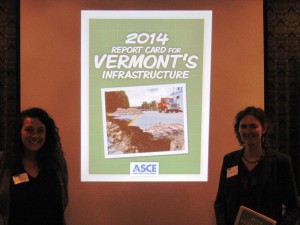
Tags: bridges, dams, grade, infrastructure, report card, roads, transportation, Vermont, wastewater, water
No Comments »
Hawaii Votes on Funding Dam and Reservoir Repairs
October 15th, 2014 | By: Maria Matthews
On November 4, Hawaii voters will decide whether “special purpose revenue bonds” will be sold as a means of generating financial assistance to dam and reservoir owners to aid in improvements or maintenance to ensure compliance with safety standards. Amendment 5, a constitutional amendment, will read as follows: “Shall the State be authorized to issue special purpose revenue bonds and use the proceeds from the bonds to offer loans to qualifying dam and reservoir owners to improve their facilities to protect public safety and provide significant benefits to the general public as important water resources?.” A vote “for” will allow the legislature to issue “special purposes revenue bonds” that will provide needed assistance to owners without placing an undue burden on the state. A similar measure was defeated by voters in 2012. In order to take effect the measure must not only win a majority of votes on this proposal but, must also win a majority of all voters in this election. This makes it ever more critical to ensure funds are available to assist all dam/reservoir owners. To ensure additional funds can be made available to improve Hawaii’s dams and reservoirs, protect public safety and preserve important water sources, remember this when you vote: ✓ Special Purpose Revenue Bonds will not create an additional burden for the state or taxpayers. ✓ Both public and private entities will have an opportunity to seek out special purpose bonds. ✓ The measure will have no effect on current or future tax rates or spending levels. ✓ Breaches not only create a public safety risk but, can cause significant damage to infrastructure in the surrounding area. Ensuring funds are available for dam and reservoir improvement is in the public interest. Amendment 5 is supported by the ASCE Hawaii Section in addition to local Chamber of Commerce and a number of agricultural and land use groups. It is also one of 15 legislative proposals endorsed by the Hawaii Department of Land and Natural Resources in 2014. Preserve the integrity of dams and reservoirs throughout the state by supporting this important ballot measure!Tags: 2014BallotInitiatives, dams, infrastructure
No Comments »
Everything You Need to Know About the 2014 Water Resources Reform Development Act
June 17th, 2014 | By: Whitford Remer
President Obama last week signed a $12.3 billion water resources bill that will modernize critical water infrastructure while also promoting economic growth and job creation. The Water Resources Reform and Development Act of 2014 (WRRDA) authorizes 34 new Army Corps projects, establishes a new loan financing program, strengthens levee and dam safety programs and codifies new reforms to the project review process. There are a number of significant victories for ASCE and the nation’s infrastructure. The legislation is the first major water resources bill in seven years and is being applauded by organizations across the spectrum. ASCE’s 2013 Report Card for America’s Infrastructure graded the nation’s ports a C, inland waterways a D-, dams a D, and levees a D-. ASCE lobbied Congress to pass the bill and is particularly supportive of the Levee Safety Initiative and The National Dam Safety Program. The national Levee Safety Initiative will promote consistent safety standards, create levee safety guidelines and provide funding assistance to states for establishing participating levee safety programs. WRRDA authorizes $395 million to support levee safety initiatives and $70 million over five years for dam safety. Once funded, these programs will provide critical resources necessary to improve the safety of the nation’s dams and levees. The bill also solves long standing expenditure issues in the Harbor Maintenance Trust Fund (HMTF). WRRDA authorizes that 100% of funds collected by the HMTF to be allocated to the intended purpose (dredging the nation’s ports and harbors) by 2025. Previously only a fraction of funds collected by the fund were used to support port and harbor programs. The bill also allocates 10% of HMTF expenditure for emerging harbors. WRRDA makes a number of changes to the popular Clean Water State Revolving Fund (CWSRF) and creates a new water financing pilot program similar to TIFIA for surface transportation projects. The new SRF provisions provide loan flexibility, lower interest rates and extended repayment periods of 30 years. SRF funds may also now be used to implement watershed plans, water conservation, stormwater recapture, and for technical assistance to small and medium treatment works. A significant win for the engineering community is the requirement for the use of the Brooks Act qualifications based selection for A/E services or an equivalent State qualifications-based requirement (as determined by the Governor of the State when using SRF fund). ASCE has worked to include this provision for over 10 years. The Water Infrastructure Finance and Innovation Act (WIFIA) is intended to increase flexibility for non-federal interests and leverages private sector investments to increase the effect of federal funding. The new WIFIA program can be used for traditional clean water and drinking water project, and also will provide assistance to projects with the goal of reducing flood damage; restoring aquatic ecosystems; improving inland and intracoastal waterway navigation systems. Finally, the bill includes new reforms at the U.S. Army Corps of Engineers that codifies a new internal expedited project delivery process that limits feasibility studies to 3 years at a cost of no more than $3 million in federal funding. ASCE applauds Congress for their bipartisan work passing WRRDA. We look forward to working with appropriators to ensure these programs and projects are properly funded.Tags: clean water, dams, economy, levees, sustainability, water, waterways, wrrda
2 Comments »
ASCE commends passage of Water Resources Reform and Development Act
May 22nd, 2014 | By: Becky Moylan
Washington, D.C. — The following is a statement from Randall (Randy) S. Over, P.E., F.ASCE, president of the American Society of Civil Engineers (ASCE), regarding the final passage today of the Water Resources Reform and Development Act by the U.S. Senate and House of Representatives: “Today’s congressional passage of the Water Resources Reform and Development Act (WRRDA) is a defining moment for the nation’s ports, inland waterways, dams, levees and clean water infrastructure. The bill will provide significant funding — $12.3 billion over ten years — to modernize critical infrastructure while also promoting economic growth and job creation. “ASCE’s 2013 Report Card for America’s Infrastructure graded the nation’s ports a C, inland waterways a D-, dams a D, and levees a D-. Since the release of our 2013 Report Card, we’ve urged Congress to pass water resources legislation that would revitalize these languishing sectors. After seven years with no legislative action to modernize the nation’s water resources, this bill will definitively move the ball forward to help raise the grades on America’s infrastructure.“ASCE applauds Congress for its decisive and bipartisan action in getting WRRDA over the finish line. This bill will ensure that our nation’s ports, waterways, dams and levees receive the funding they require so that the United States remains competitive in the 21st century. We look forward to the legislation being signed into law by the president in the coming days.”
Founded in 1852, the American Society of Civil Engineers represents more than 145,000 civil engineers worldwide and is America’s oldest national engineering society. ASCE’s 2013 Report Card for America’s Infrastructure, graded America’s cumulative GPA for infrastructure at a D+. The Report Card app for Apple and Android devices includes videos, interactive maps and info-graphics that tell the story behind the grades, as well as key facts for all 50 states. For more information, visit www.asce.org and follow us on Twitter, @ASCETweets and @ASCEGovRel.###
Tags: congress, dams, infrastructure, levees, ports, water, water infrastructure, wrrda
No Comments »
ASCE Applauds U.S. Senate Conference Report on Water Resources Reform and Development Act
May 15th, 2014 | By: America's Infrastructure Report Card
Washington, D.C. — The following is a statement from Randall (Randy) S. Over, P.E., F.ASCE, president of the American Society of Civil Engineers (ASCE) regarding the conference report on the Water Resources Reform and Development Act by the U.S. Senate: “Today’s release of the conference report on the Water Resources Reform and Development Act (WRRDA) represents a major victory in providing the necessary funding to modernize the nation’s ports, inland waterways, dams and levees. The bill promotes economic growth and job creation through policies that strengthen U.S. infrastructure, allowing the United States to remain competitive in the 21st century. “ASCE’s 2013 Report Card for America’s Infrastructure graded the nation’s ports a C, inland waterways a D-, dams a D, and levees a D-. Our nation’s water resources are critical to our economy, our infrastructure, public safety, and the preservation and enhancement of our environmental resources. In fact, ASCE’s Failure to Act economic study on the nation’s marine ports and inland waterways shows that underinvesting in just these two sectors threatens more than one million U.S. jobs and $270 billion in U.S. exports by 2020. “WRRDA will drastically reduce the time it takes for project approvals by consolidating or eliminating duplicative studies, allowing concurrent reviews, and streamlining environmental reviews. The significant reforms in the law are not at the expense of environmental quality and will allow for a stronger, safer national water resources infrastructure. In addition, ASCE applauds the reauthorization of the National Dam Safety Program, the strengthening of the Levee Safety Initiative, and the efforts to put the trust back into the Harbor Maintenance Trust Fund so that our nation’s ports can remain competitive on a global level. “ASCE is pleased that Congress has collaborated on a final conference report on WRRDA to invest in America’s future. This decisive action will ensure that our nation’s ports, waterways, dams and levees receive much-needed funding. We look forward to the final vote next week and the legislation being signed into law by the president.” Founded in 1852, the American Society of Civil Engineers represents more than 145,000 civil engineers worldwide and is America’s oldest national engineering society.###
Tags: congress, dams, infrastructure, levees, ports, water, wrrda
No Comments »
Georgia's C Infrastructure
January 13th, 2014 | By: Infrastructure Report Card
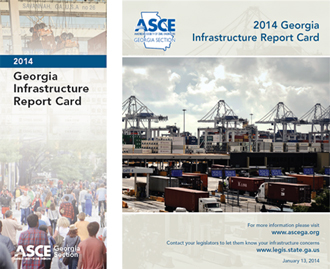 Georgia’s infrastructure has failed to improve over the last five years. In a new report, titled the 2014 Report Card for Georgia’s Infrastructure, the Georgia Section of the American Society of Civil Engineers (ASCE) awarded the state’s infrastructure a “C,” a grade unchanged from their 2009 Report Card. The lowest grade awarded was a “D-”, which went to the state’s dams and transit systems. The Report Card’s highest grade, a “B,” was given to Georgia’s energy and rail systems. Georgia’s growing population combined with cutbacks in infrastructure funding resulted in many of the low grades.
Specifically, the Report Card finds that Georgia is lagging in sustainable investment, including:
Georgia’s infrastructure has failed to improve over the last five years. In a new report, titled the 2014 Report Card for Georgia’s Infrastructure, the Georgia Section of the American Society of Civil Engineers (ASCE) awarded the state’s infrastructure a “C,” a grade unchanged from their 2009 Report Card. The lowest grade awarded was a “D-”, which went to the state’s dams and transit systems. The Report Card’s highest grade, a “B,” was given to Georgia’s energy and rail systems. Georgia’s growing population combined with cutbacks in infrastructure funding resulted in many of the low grades.
Specifically, the Report Card finds that Georgia is lagging in sustainable investment, including:
- Georgia ranks 49th in the nation in per capita transportation funding.
- Georgia is among the lowest in the country in transit spending per resident. According to the American Public Transportation Association’s 2010 Survey of State Funding for Public Transportation, Georgia spent just $0.63 per person in 2008. In comparison, New Jersey spent $119.52, Illinois spent $40.43, and North Carolina spent $7.94 per person in the same year.
- Georgia’s Safe Dams Program has faced over a 50% cut in staff since 2003, with each safety official now expected to oversee over 1,000 dams, or five times the national average.
- MARTA is the largest transit agency in the country to not receive state funding support for operations
- Georgia’s state motor fuel excise tax—which funds surface transportation projects—is one of the lowest in the United States
Tags: dams, grades, infrastructure, report card, state, transit, transportation, water
1 Comment »



 */ ?>
*/ ?>





